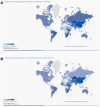Epidemiology of esophageal cancer
- PMID: 24039351
- PMCID: PMC3769895
- DOI: 10.3748/wjg.v19.i34.5598
Epidemiology of esophageal cancer
Abstract
Esophageal cancer (EsC) is one of the least studied and deadliest cancers worldwide because of its extremely aggressive nature and poor survival rate. It ranks sixth among all cancers in mortality. In retrospective studies of EsC, smoking, hot tea drinking, red meat consumption, poor oral health, low intake of fresh fruit and vegetables, and low socioeconomic status have been associated with a higher risk of esophageal squamous cell carcinoma. Barrett's esophagus is clearly recognized as a risk factor for EsC, and dysplasia remains the only factor useful for identifying patients at increased risk, for the development of esophageal adenocarcinoma in clinical practice. Here, we investigated the epidemiologic patterns and causes of EsC. Using population based cancer data from the Surveillance, Epidemiology and End Results Program of the United States; we generated the most up-to-date stage distribution and 5-year relative survival by stage at diagnosis for 1998-2009. Special note should be given to the fact that esophageal cancer, mainly adenocarcinoma, is one of the very few cancers that is contributing to increasing death rates (20%) among males in the United States. To further explore the mechanism of development of EsC will hopefully decrease the incidence of EsC and improve outcomes.
Keywords: Barrett’s esophagus; Cyclin D1 G870A; Esophageal neoplasm; Polymorphism; Risk factor; Susceptibility.
Figures
References
-
- Esophageal cancer: epidemiology, pathogenesis and prevention. Nat Clin Pract Gastroenterol Hepatol. 2008;5:517–526. - PubMed
-
- Pennathur A, Gibson MK, Jobe BA, Luketich JD. Oesophageal carcinoma. Lancet. 2013;381:400–412. - PubMed
-
- Mao WM, Zheng WH, Ling ZQ. Epidemiologic risk factors for esophageal cancer development. Asian Pac J Cancer Prev. 2011;12:2461–2466. - PubMed
-
- Enzinger PC, Mayer RJ. Esophageal cancer. N Engl J Med. 2003;349:2241–2252. - PubMed
Publication types
MeSH terms
LinkOut - more resources
Full Text Sources
Other Literature Sources
Medical
Research Materials



